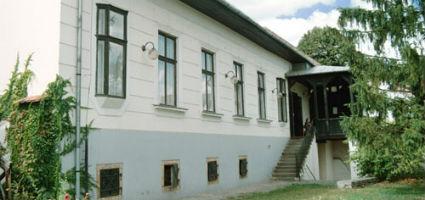2025. April 26. Saturday
Ferenczy Museum - Vajda Museum - Szentendre
 |
Address: 2000, Szentendre Hunyadi u. 1.
Phone number: (20) 779-6657
E-mail: info@muzeumicentrum.hu
Opening hours: Thu-Sun 10-18
|
Museum tickets, service costs:
|
Individual ticket for adults
|
3000 HUF
|
/ capita
|
|
Group ticket for adults
(min. 10 people)
|
2200 HUF
|
/ capita
|
|
Individual ticket for students
|
1500 HUF
|
/ capita
|
|
Group ticket for students
(min. 10 people)
|
800 HUF
|
/ capita
|
|
Individual ticket for pensioners
|
1500 HUF
|
/ capita
|
|
Ticket for families
(2 adults + max. 3 children)
|
4000 HUF
|
/ family
|
|
Group guide
|
14000 HUF
|
/ group
|
|
Group guide
|
22000 HUF
|
/ group
|
Thinking along the lines of pictures by Lajos Vajda (1908-1941) brought new dimensions in Hungarian fine art. His interests were Serbia, Szentendre, the so-called Work Circle of Kassák, Paris in 1930-34, and the Fine Art Collage of Budapest.
After making his cubist pictures in his early period, he did photo montages in Paris. In 1935-36 collaborated with the painter Dezső Korniss on the Szentendre Program which was influenced by and similar to the collaboration of Bartók and Kodály. The aim of the program is to synthesize between past and present, eastern and western thoughts. On their journeys in the town and around in search of motifs, Vajda used to unify the everyday and the sacred objects simplified according to the constructive Surrealist method built on the theory of montage into signs with vernacular motifs. An example of this is his picture titled 'Houses of Szentendre with Crucifix'.
The possibility to create synthesis seemed to be lost at the time of Fascism and Stalinism. Instead, Vajda set off on a journey towards the depth of the lonely soul. On his way, he met figures who masked their human faces into apparitions, flowers that grew deadly teeth, and saw never before seen horrifying lands. In the drawing art of the 20th century of Europe, the ancient material that is formed by elemental powers in his large coal drawings is very significant.
The possibility to create synthesis seemed to be lost at the time of Fascism and Stalinism. Instead, Vajda set off on a journey towards the depth of the lonely soul. On his way, he met figures who masked their human faces into apparitions, flowers that grew deadly teeth, and saw never before seen horrifying lands. In the drawing art of the 20th century of Europe, the ancient material that is formed by elemental powers in his large coal drawings is very significant.